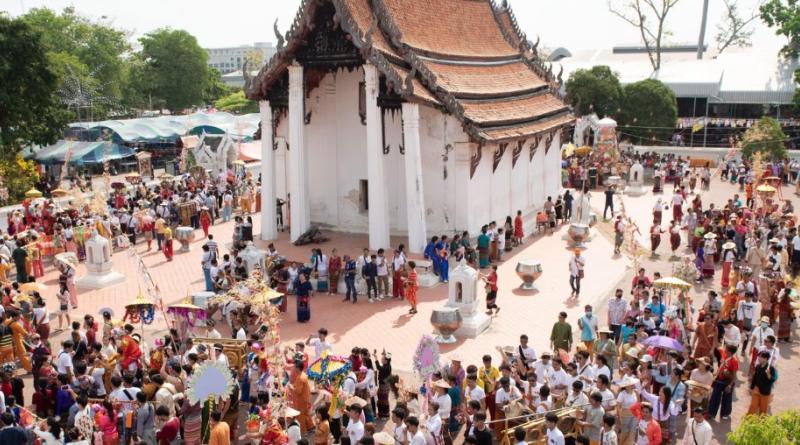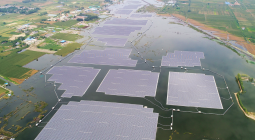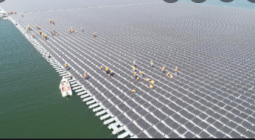History fades as rising sea levels slowly destroy Thailand’s temple murals

Saltwater damage could see precious historical Buddhist artworks dating back hundreds of years slowly fade entirely from view
If you look closely, you can just about see the characters and scenes that once stretched across the walls of Wat Prasat, a temple in Nonthaburi. There’s the dark shape of an elephant’s head, a figure slouching on its back; outlines of swords pointing upwards to the centre of the display; patches of curved roofs.
“The mural used to be more vivid,” says Phra Maha Natee, the abbot of Wat Prasat. Even when he was a novice monk, 20 years ago, the image – which shows one of the jātakas stories that recall the Buddha’s past lives – was easier to understand. “The colour was brighter and sharper,” he says.
The murals offer a glimpse into a past era - a time of prosperity but also social upheaval, when a more empowered nobility had emerged, as did a desire, say historians, for Buddhism to play a more stronger role in reinforcing discipline in society. They date back to the mid or later years of the Ayutthaya kingdom in Siam, which existed from 1351 to 1767, in what is now Thailand and are a treasured early example of the art form.
They have weathered the elements for hundreds of years and historians have described them as part of a landmark moment in the cultural history of Siam. They not only made temples more attractive, but also relayed moral lessons. Now Phra Maha Natee fears the designs on the walls of Wat Prasat could disappear completely within a couple of decades.
Murals in temples across Thailand face the risks of flooding, pollution and poor planning but conservationists say the main danger is another, more existential threat: saltwater intrusion from rising sea levels sparked by the climate crisis.
Wat Prasat is in Nonthaburi a low-lying province less than 60km from the coast, and is especially vulnerable. Drought and rising sea levels are increasingly causing saltwater from the Gulf of Thailand to intrude into the Chao Phraya river, the main source of water in central Thailand. The saltwater can destroy crops, at huge cost to farmers, and render tap water unsafe. It is also threatening to degrade historic temples, by seeping up from the ground, causing concrete walls to crumble, and their paintings to flake and disappear forever.
Thailand’s Fine Arts Department, the government body responsible for heritage conservation, said that salt moisture is the biggest issue it finds in the temples it has been called to survey for damage. The effects are gradual and can take decades to show, but it is feared the problem will only get worse.
“With the sea water level getting higher, the salt[water] is coming into the land more,” says Kiriya Chayakul Sitthiwang, an academician at the department. “[It] means that in the future more heritage sites will be impacted from this salt moisture,” says Kiriya, who added the problem was now affecting areas as far away as Chai Nat province, more than 200km north of the Bay of Bangkok.
‘You could see the salt stain on the wall’
At Wat Prasart, dusty fragments that have fallen from the walls collect at the edges of the carpet. The sidewalls – which feature five of the 10 jātaka stories about the Buddha, separated by devotional figures – have faded dramatically. Sometimes you can smell the damp in the air, says Phra Maha Natee. “Sometime the district announces a warning for people not to use the water because the salinity is too high. You could see the salt stain on the wall surface,” he adds. The impact of moisture has been gradual, he adds, but accelerated after the 2011 floods, which inundated Bangkok and neighbouring provinces for weeks, and led to more than 800 deaths.
Opposite the temple hall, colourful lanterns decorate the grounds, and charms and amulets are advertised for visitors. The temple is in a quiet area of the province and usually becomes crowded only on religious holidays. Some visitors are drawn too by stories of the grounds being haunted, says Phra Maha Natee, who adds that Thai TV once used the area as a setting for ghost stories. Scholars, too, visit to study the temple’s history. Thanapon Junkasain, Assistant Professor at the faculty of architecture and design, Rajamangala University of Technology Rattanakosin, has used digital painting techniques to recreate the murals, as part of a research project looking at methods of mural conservation.
Pictorial stories had long featured in temples, but it was in the last century of the Ayutthaya era that murals spread far more widely, according to the historian Chris Baker, and Wat Prasat is an early example of this trend – painted before the practice became much more standardised.
Improved construction techniques, learned from Persia, meant it was possible to build temples with larger windows, meaning there was enough light for murals to be appreciated, Baker adds. Such innovations combined with broader social disruption to lead to a desire for Buddhism “to become much more of a social force,” says Baker, who previously taught Asian history at Cambridge University.
In the last century of the Ayutthaya era a rising nobility became richer and more powerful, and old systems of forced labour began to weaken. There were growing concerns about crime, corruption and disorder, and many turned to Buddhism to shore up society. Attractive murals could help strengthen the role of Buddhism, says Baker, and there was a wealthy nobility able to fund expensive projects.
‘A work of art itself’
The murals combine moral tales with celebrations of the present day – there are glimpses of the cityscape of Ayutthaya, and daily life. At Wat Pradu Songtham in Ayutthayaa, from the same period, a portrayal of the Buddha’s cremation is combined with scenes from festivals of the time – from tightrope walkers and acrobats, to Chinese opera. At the better-preserved Wat Chong Nonsi in Bangkok, which also dates from the late Ayutthaya era, uncensored, bawdy images of urban life are interspersed with the Vidhura jātaka story. In one scene, a couple’s entangled legs emerge from a bedroom window, where neighbours have gathered to peer in; downstairs, a child giggles as his friend prepares to prank a man whose testicle has become exposed as he works.
There are common themes in murals of the time, but artists also appeared to have had freedom to experiment, says Baker. “They’re unique, they’re not like one another,” he says, adding that, later on, murals became much more standardised in terms of their layout . “Each of these early wat [temples], like Wat Prasart, is a work of art itself, it should be conceived like that, rather than just an example of temple murals.”
The images at Wat Chong Nonsi are not a sneaky inclusion, but are portrayed in the middle of the temple wall, at eye level, says Baker, who described it as a form of humanism, and reflects a feeling that “life really is like this – there’s no sense in us not depicting this,” he says. There was an absence of Puritanism that eventually crept in from the west, he adds.
Move or fade
Conserving such works is expensive, however, and the Fine Arts department has a budget to fund work on only 10 temples each year – out of more than 40,000 temples across the country.
Kwanjit Lertsiri, a conservationist, says restoring and protecting heritage art is slow, meticulous work. “Sometimes it can be three to 10 years [per heritage site] depending on the project,” she said. Some experts are attempting to digitise art work to preserve history, and at times people will find ways to move the art altogether. “Sometimes if the mural is on the wooden wall, they will try to take the whole thing out and keep it in the museum,” she adds.
At Wat Prasat, piping has been installed to try to reduce moisture levels, but it isn’t clear if this will improve the situation, says Phra Maha Natee. So much of the artwork has already vanished. “It’s sad to see it’s disappearing. I have been here for a long time from a novice [monk] to an Abbot. I feel connected here,” he said. “I don’t know what to do.”
Photograph: ZUMA Press, Inc./Alamy






